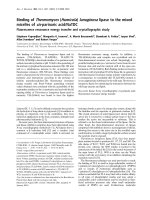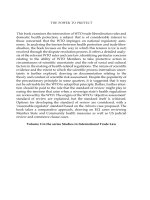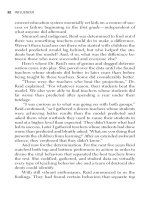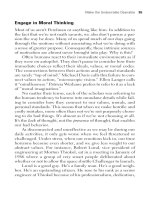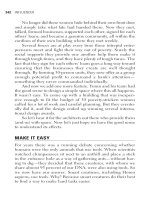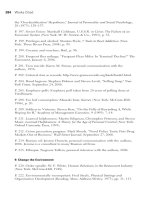Influencer The Power to Change Anything by Kerry Patterson, Joseph Grenny, David Maxfield and Ron McMillan_13 ppt
Bạn đang xem bản rút gọn của tài liệu. Xem và tải ngay bản đầy đủ của tài liệu tại đây (762.89 KB, 21 trang )
242 INFLUENCER
No longer did these women hide behind their own front door
and simply take what fate had handed them. Now they met,
talked, formed businesses, supported each other, signed for each
others’ loans, and became a genuine community, all within the
confines of their own building where they met weekly.
Several forces are at play every time these intrepid entre-
preneurs meet and fight their way out of poverty. Surely the
social supports they provide one another help them make it
through tough times, and they have plenty of tough times. The
fact that they sign for each others’ loans goes a long way toward
ensuring that the businesses they create are well thought
through. By forming 30-person units, they now offer as a group
enough potential profit to command a bank’s attention—
something they never commanded individually.
And now we add one more feature. Yunus and his team had
the good sense to design a simple space where this all happens.
It wasn’t easy. To come up with a building that was inexpen-
sive enough to fit the budget of 30 poverty-stricken women
called for a lot of work and careful planning. But they eventu-
ally did it, and the design ended up winning several interna-
tional design awards.
So let’s hear it for the architects out there who provide them
(and us) with space. Now let’s just hope we have the good sense
to understand its effects.
MAKE IT EASY
For years there was a running debate concerning whether
humans were the only animals that use tools. When scientists
watched chimpanzees sit next to an anthill and place a stick
in the entrance hole as a way of gathering ants—without hav-
ing to dig—they decided that these creatures, with whom we
share almost 95 percent of our DNA, were also using tools. So
we now have our answer. Smart creatures, including Homo
sapiens, use tools. Why? Because smart creatures do their best
to find a way to make hard tasks easier.
Change the Environment 243
Around a century ago, Frederick Taylor, the father of sci-
entific management, decided that it was time that we tool users
start using tools more wisely. After noticing that employees at
Bethlehem Steel used but one shovel size for every task, he
determined that the most effective load was 21
1
⁄2 pounds and
set about designing and purchasing shovels of different sizes to
ensure that no matter the medium, the weight employees
hefted would always be the same. Never again would employ-
ees shovel slag and snow with the same instrument.
Nowadays you can’t throw a rock without hitting someone
who does similar time-study work. These folks aren’t merely
studying best practices; they study common practices and then
through careful analysis make them better. Unfortunately, the
principles of this discipline haven’t always found their way into
complex human problems such as divorce, obesity, drug abuse,
credit card addiction, and AIDS transmission. Dr. Whyte (the
innovator behind the restaurant spindle) brought an engineer-
ing solution to a social issue, but most people don’t naturally
think of industrial engineering as a resource for overcoming
human challenges.
Influence whizzes don’t make this mistake. They apply effi-
ciency principles at the very highest level. Rather than con-
stantly finding ways to motivate people to continue with their
boring, painful, dangerous, or otherwise loathsome activities,
they find a way to change things. Like an ape fashioning a stick
to its needs, they change things in order to make the right
behaviors easier to enact. And depending on whether the glass
is half empty or half full, they also use things to make the wrong
behaviors more difficult to enact.
For example, one of the main reasons the Guinea worm dis-
ease was eradicated so effectively across the sprawling subcon-
tinent of India was that influence masters took steps to make it
far easier to drink good water than to drink bad water. Here’s
the strategy they implemented.
In developing-world villages, women often spend several
hours each day traveling to and from the local water source.
244 INFLUENCER
Hours that could have been spent in more fruitful or even
enjoyable activities are expended walking back and forth to a
pool while hauling a heavy pot. If this isn’t bad enough, the
pools these dedicated women hike to and from are often teem-
ing with water fleas that are, in turn, filled with Guinea worm
larvae.
Earlier we explained that change agents from The Carter
Center had learned that villagers who filtered the water through
their skirts had diminished the Guinea worm disease problem.
Let’s add some more detail to that project. In order to make it
easier to filter the water effectively (many skirts didn’t filter the
water very well), The Carter Center set out on a campaign to
develop an affordable and long-lasting cloth filter. People at the
center knew that if they could find a way to get an effective,
efficient, and durable filter into the hands of everyone who
drew water, the parasite could be eliminated.
Former U.S. President Jimmy Carter, in his work with the
center, explained how this all-important filter came about:
I went to see Edgar Bronfman, whose family owned
about 20 percent of E.I. DuPont Company. I asked
Edgar if he would donate $250,000 over a five year
period, which in those days was a lot of money. He asked
me, “What are you going to use the money for?” And I
answered: “The best way to do away with the Guinea
worm is to pour water through a very fine filter cloth.”
And he said, “Like this napkin on the table?” And I said,
“Yes.” “Then why don’t you use napkins?” he asked. I
explained, “Well, because if you take this napkin and wet
and dry it eight or ten times a day, in the tropics it’ll rot
in a couple of weeks.” And he responded, “Well, maybe
we could help.”
Bronfman took the case to the DuPont board of directors,
which knew of a company in Switzerland that produced a
nylon fiber that would likely serve this purpose—a fiber that
Change the Environment 245
wouldn’t rot in the tropics. DuPont provided these fibers to a
company that does precision weaving, and they created the
material for the filters. DuPont then donated 2 million square
yards of this cloth to The Carter Center.
“This was the main resource we used to get rid of the
Guinea worm,” President Carter concluded.
Once the specialized cloth had been produced, the task of
getting people to filter their water was made a great deal eas-
ier, and with the help of that simple invention the parasite
began disappearing in hundreds of villages.
In India, there was an even more elegant engineering solu-
tion available than simply making it easy to filter the water
effectively. Unlike sub-Saharan Africa, in India clear, clean
water runs close to the surface of the earth. So engineers
drilled and capped bore-hole wells in hundreds of villages
across the country. This simple one-time strategy made safe
water far more accessible and bad water much harder to get to.
Guinea worm in India, robbed of its hosts, died off rapidly.
Much of Delancey’s success also depends on making the
right behavior easier while making the wrong behavior more
difficult. This is particularly true when it comes to drug abuse.
Imagine the challenge of ensuring that new residents succeed
during their first few drug-free weeks. Withdrawing from heroin
is described as one of the most excruciatingly painful trials you
can experience. Addicts who come to loathe the drug, and who
experience little benefit from the high after years of abuse, con-
tinue to use the drug just to avoid the pain of withdrawing.
And yet almost every heroin addict who comes to Delancey
makes it through this agonizing period. Why? In part because
they’ve changed their zip code. Minutes before walking
through the front gate, new residents’ environment had been
filled with people who used, supplied, or supported their addic-
tive behavior. Now they’re in a dorm with eight other people
who don’t. And outside the dorm are another 50 residents on
their floor who don’t. And in their building are another 200
246 INFLUENCER
who don’t. In order to get to drugs, residents would now have
to go to much greater lengths and distances than ever before.
And all of this happens because Dr. Silbert understands the
importance of making the wrong behavior hard, and the right
behavior easy—or at least easier.
If you’re not a drug addict and don’t have worms, what can
this simple principle do for you? Or maybe for our friend
Henry? Here’s some more good news on the diet front. Brian
Wansink has shown that if you make good eating choices a lit-
tle easier and bad ones a little harder, you can make a substan-
tial dent in your waistline.
For example, Brian Wansink found that plate size affects
the amount of food a person will eat during a meal before
deciding that he or she is satisfied. Smaller plates left people
satisfied with smaller portions. If you want to eat fewer calo-
ries, change the dishes sitting in your cupboard. He also learned
that the positioning of snacks and whether packaging is clear
or opaque can increase or decrease consumption by 50 percent
or more. A candy jar placed on a desk rather than a few feet
away on a bookshelf can double the amount of candy con-
sumed—once again, propinquity at work. Ice cream with a
clear top in the freezer is much more likely to be eaten than
the same treat in a cardboard box.
And when it comes to using your exercise equipment, you
can bet that distance also takes its toll. Move your exercise bike
from your TV room to your basement, and you’ve just dramat-
ically cut your chances of using it. Travel to a gym for your
routine cardiovascular exercise (as opposed to using a piece
of home equipment), and this too will lessen your chances
substantially.
So, if you’re one who struggles to maintain a healthy
lifestyle, do a quick inventory of things that affect your behav-
ior. Take a count of how many bad food choices are within your
reach at each hour of a typical day. Then take a count of how
many good choices are within the same distance. Look at how
difficult it is for you to exercise. Do you have to walk to a dis-
Change the Environment 247
tant and socially isolated room to get to your equipment? Do
you have to unpack something from a closet before you can get
started?
Discover how many items in your home you can simply
move to make the right behavior easier and the wrong behav-
ior more difficult. Sure, you can always hunker down, gut it out,
and suffer as a way of ensuring that you eat right and exercise
regularly. You can always plug in a motivational tape to keep
your spirits high in order to climb that mountain. Or you can
just make the right things easier to do and the wrong things
more difficult to do. It’s your call.
Health-care institutions have also learned the importance of
making the correct behavior easier. Consider what many insti-
tutions are doing to reduce medication errors. In the past, pills
came in only a reddish brown bottle that offered no informa-
tion about its content and looked just like the reddish brown bot-
tle next to it. Oops. Couple this challenge with the fact that
many people who fill medical orders do so after pulling back-
to-back shifts while squinting to read that pharma-chicken-
scratch that passes as a prescription, and it’s easy to see why
medication errors cause tens of thousands of deaths annually.
Nowadays progressive pharmaceutical companies and hos-
pitals are teaming up to make the right choices obvious. By deft
use of colored bottles and better labels, many hospitals have sig-
nificantly reduced medication errors and subsequently need-
less deaths. It seems odd that something as important as not
killing patients could be affected as recently as a few years ago
with an intervention as simple as, well, making the right behav-
ior simple. But, then again, when it comes to changing human
behavior, most people would rather motivate the guilty—for
instance, suing the blighters who spoon out the wrong drugs—
than enable them. And when it comes to enabling others, we
often turn to training before we look for ways to make the task
easier to perform.
At the corporate level, companies are becoming more
attuned to the concept of making the right behavior, such as
248 INFLUENCER
buying their product, easier. For instance, consumer guru
Paco Underhill helped increase the sales of doggie treats by
making it just a little easier to take them off a shelf. Underhill
found that young and middle-aged adults were more likely to
buy animal treats than were the elderly and children. This
piqued his curiosity. He videotaped customers on the pet aisle
and quickly discovered what was keeping treat sales low among
certain age groups. Typically the staple items like pet food were
on the eye- and waist-level shelves, while treats were placed on
higher shelves.
It turns out that the young and old find it significantly more
difficult to reach items on a higher shelf. One video clip
showed an elderly woman attempting to use a carton of alu-
minum foil to knock down a package of treats. Another revealed
a child dangerously climbing shelves to try to reach the pack-
age. Moving the treats down one shelf made the behavior just
easy enough to boost sales immediately.
But not everyone is listening. In fact, Bill Friedman, one
of the biggest gurus on the effects of the environment on
human behavior, is being systematically ignored. He studies
gambling casinos. By watching thousands of hours of video of
people gambling, he has discovered an interesting fact. The fea-
tures that make a hotel attractive make gamblers miserable.
Las Vegas hotels compete on the basis of their size and
splendor. The higher the ceilings and the longer the vistas, the
more valued the hotel. Gamblers, in contrast, seek small, inti-
mate places. When you think about it, sitting in front of a one-
armed bandit and pulling a lever is actually quite boring. You’d
have to pay production-line workers good money to do such
things. What people find interesting at a casino is not the task
of gambling, but the interactions they have with other people.
The job of gambling is made more fun (a surrogate for easy),
when other people are around. Consequently, when Friedman
helps owners transform large unfriendly venues into cozy ones,
profits soar.
Change the Environment 249
But big Vegas hotels nowadays are competing as big hotels,
so they ignore Friedman’s advice and make massive, un-
friendly casinos. Consequently, many modern hotels barely
break even on their gambling (blasphemous in years past) and
rely on entertainment, room costs, and restaurants to make
money. Nevertheless, the principle is still the same. If you fol-
low the guru’s advice and make gambling more pleasant (that
is, easy) by making it cozy and friendly, you’ll make money
hand over fist. But then again, maybe that’s just too easy.
MAKE IT UNAVOIDABLE
Making use of things to enable behavior works best when you
can alter the physical world in a way that eliminates human
choice entirely. You don’t merely make good behavior desir-
able, you make it inevitable. This is where structure, process,
and procedures come into play, and, once again, the corporate
world leads the way. Engineers, tiring of reminding employees
not to stick their fingers in certain machines, build in mechan-
ical features that prevent people from putting their hands at
risk. Pilots follow lockstep procedures and rigid checklists that
require them to double- and triple-check their takeoff and land-
ing procedures.
When it comes to the fast-food industry, we’ve hardwired
tasks that used to call for talent, and that often used to put cus-
tomer satisfaction and profits at risk. For example, when it
comes to taking an order, employees can simply push picture
buttons, and of course, nobody has to know how to make
change because the register does it automatically. It’s all been
routinized. When it comes to taking an order and making
change, it’s not only easy to do the right thing, it’s now almost
impossible to do the wrong thing.
However, when it comes to the profound and complex
social problems we’ve been addressing, we’re not as good at
hardwiring successes through the manipulation of the physical
250 INFLUENCER
environment. Fortunately, this is fairly easy to change. Often all
that’s required to make good behavior inevitable is to structure
it into your daily routine. If we’ve learned only one thing about
today’s overscheduled world, it’s that structure drives out lack
of structure. Meetings happen. On the other hand, “I’ll get back
to you sometime later”—maybe that won’t happen. So if you
want to guarantee a positive behavior, build it into a special
meeting or hardwire it into an existing meeting agenda.
For example, the CEO of a large defense contracting com-
pany the authors worked with saw a massive increase in inno-
vative breakthroughs when he and his senior leadership team
scheduled and met regularly with groups of employees to
solicit ideas. This calendared practice created a forum that
encouraged and enabled new behaviors, thereby making the
right behavior inevitable. At Delancey, Silbert makes use of cal-
endared events by taking them one step further and transform-
ing them into rituals. These ordered procedures consist of
hardwired meetings that are never missed and that are highly
symbolic, quite volatile, and enormously effective at making
the right behavior inevitable. Consider the Delancey ritual
referred to simply as “Games.” This particular ritual is not
always fun, but it’s always done.
Say you’re a resident at Delancey. Three times a week you
and members of your minyan get together to dump on each
other. A disinterested person ensures that nothing gets physi-
cal, but beyond that it’s pretty unstructured. During “Games”
people learn the egalitarian approach to feedback that
Delancey wants. Anyone can challenge anyone. If you think
your crew boss is a jerk, you give him a slip of paper inviting
him to a Game. He must show up. And when he’s there, you
can unload on him to your heart’s content. Anyone from
Silbert on down can be invited to a Game by anyone else.
Over time, the quality of Games increases as the volume
decreases. Residents become better at sharing feedback. What
doesn’t change is that this long-standing ritual makes the right
Change the Environment 251
behavior inevitable. People don’t like to confront others—
particularly scary and powerful others. Left to their own
proclivities, residents would do what anyone else would do—
toggle from silence (holding our complaints inside) to violence
(blowing up in a verbal tirade). So Silbert turns feedback into
a ritual, calls it Games, and then lets the Games begin. Three
times a week without fail.
SUMMARY: CHANGE THE ENVIRONMENT
When you first read that sociophysical guru Fred Steele thinks
that most of us are environmentally incompetent, it’s only
natural to become defensive. That’s a harsh term. Who died
and left him in charge of measuring our competency? But then
when you read of the dozens of environment-based strategies
influence masters routinely employ as a means of bringing
about change, you realize that most of us really don’t turn to
the power of propinquity or the data stream or any other phys-
ical factor as a means of supporting our influence efforts.
When it comes to developing a change strategy, we just
don’t think about things as our first line of influence. Given that
things are far easier to change than people, and that these
things can then have a permanent impact on how people
behave, it’s high time we pick up on the lead of Whyte, Steele,
Wansink, and others and add the power of the environment to
our influence repertoire. And who knows? Someday an every-
day person may even be able to say the word propinquity in
public without drawing snickers.
This page intentionally left blank
253
10
Become an Influencer
I was going to buy a copy of
The Power of Positive Thinking
,
and then I thought: What the hell good would that do?
—Ronnie Shakes
T
his book started with a bold assertion. We claimed
that if you bundle the right number and type of in-
fluence techniques into the right influence strategy, you
can change virtually anything. At first blush this claim seems
both cocky and unbelievable. Obviously there are thousands
of things out there that none of us will ever change. Take grav-
ity, for example. It’s been around for a while and doesn’t
appear to be going anywhere. From there we explained that
we’re referring to the behaviors that cause most of the profound
and persistent problems that we’re currently experiencing.
There is a growing body of knowledge as well as an impres-
sive supply of real-life success stories that teach exactly how to
change almost any human behavior. Read the scholarly works
of Dr. Albert Bandura. Then watch what Dr. Mimi Silbert does
at Delancey Street. These two influencers alone demonstrate
that, if you know what you’re doing, you can indeed change
remarkably resistant behaviors.
For example, today at Delancey, 500 former criminals and
drug addicts are willingly immersed in an intense environment
that employs every influence strategy we discussed. The strate-
Copyright © 2008 by VitalSmarts, LLC. Click here for terms of use.
254 INFLUENCER
gies have been put into place to help each resident transform
from a habitual offender into a productive citizen.
Naturally, bringing about the profound transformation of
these 500 people isn’t easy. It’s never easy to get people to
change deeply entrenched behaviors, and when you’re work-
ing with people whose résumés include an average of four
felony convictions, you’re dealing with a population that has
one unhelpful characteristic in common. The residents may
come from different gangs, ethnic groups, or even criminal
portfolios, but they have all failed to turn their lives around.
Before joining Delancey, each time these criminals matric-
ulated into the penal system only to return to a life of crime,
the penal system failed them. Each time some may have sworn
to their family members that next time they’d get it right—and
then got it wrong—they let down their loved ones. Each time
some may have vowed to break their vile habits and promptly
returned to their old ways, they let themselves down. And each
time they failed to transform into a new person, they failed
because not one of them brought together a comprehensive
enough influence strategy to remake themselves.
All 500 of them had repeatedly failed before showing up at
Delancey Street.
Yet Dr. Mimi Silbert’s approach routinely transforms 90 per-
cent of these habitual failures into law-abiding citizens. Dr.
Silbert succeeds more than others not because she cares more
than other change agents or because she spends more money.
In fact, the operation funds itself through its own efforts. To date,
Silbert has succeeded in turning around over 14,000 lives
because she is a genuine card-carrying, four-star influencer. She
knows how to help people change their thoughts and actions.
In 1992 when Dr. Don Berwick and IHI started the 100,000
lives campaign, they too were taking on one of the most
entrenched establishments in the world—the U.S. health-care
system. At that particular time in history, an estimated 100,000
patients were dying each year in hospitals as the direct result
Become an Influencer 255
of a variety of preventable human errors. Berwick and his team
set out to prevent these errors. That meant that they’d have to
find a way to both enable and motivate health-care profession-
als to act in new ways.
As you might imagine, when Dr. Berwick and his col-
leagues started their campaign, some people in the health-care
system were unconscious of how their own actions might be
contributing to harm. Even those who were conscious of the
dangers lurking in their systems were often incapable of build-
ing the influence strategies necessary to bring about profound
and lasting change.
Fortunately, Berwick and his staff stuck with their campaign
until they learned exactly what it would take to change deeply
entrenched behavior. During the 100,000 lives campaign,
3,100 hospitals reduced total in-patient deaths by an estimated
122,000 over eighteen months. Today Berwick and his team
are working on a 5 million lives campaign. Imagine the grief
they’ll be preventing and the joy they’ll be bringing to the
world. They’re taking on a target that’s 50 times larger than
their original goal because they now know a great deal more
about exerting influence.
For one final update, let’s head to sub-Saharan Africa. For
several decades well-intended anthropologists and health-care
specialists did their best to encourage locals to read their worm
brochures or attend their lectures or simply to follow their
heartfelt advice. If the villagers would only listen to their ideas,
they could rid themselves of the dreaded Guinea worm disease.
But alas, few followed their advice, and the ugly scourge
plagued tens of millions.
Enter Dr. Donald Hopkins and other influence masters
from The Carter Center. Since the beginning of their cam-
paign to eradicate Guinea worm disease, this small team of
change agents has reduced the level of Guinea worm cases by
99.7 percent, completely eradicating the disease from 11 of the
20 endemic countries it originally targeted. The team is on
256 INFLUENCER
schedule to completely eradicate the scourge by 2009. Team
members have done this not through a medical breakthrough
but by learning how to motivate and enable absolute strangers
to alter their behavior. Like other influencers we’ve studied,
these devoted change agents stepped up to an enormous chal-
lenge, left behind old and failed methods, and decided that if
they wanted to solve the devastating Guinea worm problem,
they would have to start with themselves. They would first have
to learn what it would take to exert influence over human
behavior.
So they did. They visited their target audience, studied pos-
itive deviance, and brought into play many of the methods we
describe in this book. As a result, one day soon the very last
Guinea worm will have been eliminated from the face of the
earth. Forever. The horrible parasite will actually be extinct,
and this is an extinction we can live with.
Bandura, Silbert, Berwick, Hopkins—in fact, all of the
other practitioners and scholars we’ve studied—have made
stunning contributions to the change literature. They have all
succeeded where others have failed. They have all demon-
strated that if you know how to make use of the right influence
tools and bring them to bear on a carefully designed project,
you can change anything.
And best of all, each of these geniuses has given us
hope. We too can become master influencers—but not with-
out some hard work. We have to stop tinkering with problems
and learn how to build a comprehensive influence strategy.
This, of course, raises the question of whether everyday
people can actually put into play the principles influence
masters use all the time. The answer, of course, is a resound-
ing yes. None of the individuals we’ve studied were influencers
by training, but all eventually learned what it took to wrestle
persistent problems to the ground. To kick-start your personal
efforts, you’ll have to use this book as a handbook for change.
Become an Influencer 257
FIND VITAL BEHAVIORS
Start with vital behaviors. There’s no use putting together sev-
eral complex techniques all aimed at the wrong actions. That’s
where Dr. Ethna Reid’s work comes into play. Dr. Reid taught
us to look for best practice research that compares top perform-
ers to others, teases out the unique behaviors that separate the
best from the rest, and then teaches these vital behaviors to
lower-performing individuals. If they then make significant
improvements, you have something worth trying.
When you find yourself sorting through a list of possible
influence strategies, demand this same level of scientific rigor.
Accept only those recommendations that have been proven
through similar comparative analyses. Start your search by look-
ing for scholastic work. Search for university publications, fre-
quently cited research, and renowned practitioners who publish
their results. Such scientific work can be found in respected
journals and not necessarily in advertising brochures. In any
case, take the time to explore the known universe, and don’t
merely accept the first plan that comes across your desk.
After identifying the vital behaviors that have worked for
others, learn what works best for you by applying the principles
of positive deviance. Examine the times when you have suc-
ceeded, and try to identify the force or strategy that led to your
success. Once you’ve discovered the actions that have worked
for you in the past, conduct short-cycle-time mini experiments
to confirm your analysis. Don’t head off on a lifelong trek.
Instead, set short-term goals, try the behaviors within a low-risk
environment, and then see what works for you.
ADD A SOURCE
Behind each vital behavior you’ll find six distinct sources of
influence. If you’re lucky, any one of these sources might be
enough to put your change strategy over the top. For example,
258 INFLUENCER
you may have realized that if you simply build deliberate prac-
tice into your attempt to help your children love reading, you
could make enormous strides. You may have been struck with
the insanity of sending people off to corporate training pro-
grams and then dropping them back into a social climate where
no one reinforces the concepts they were taught. So you’ve
added social and structural reinforcement into the mix. Perhaps
you have carted your treadmill from the basement up to your
bedroom where you don’t have to fight the deadly power of
propinquity. In the odd event that your previous influence strat-
egy was short one or two horsepower of what was needed to cre-
ate change, picking and choosing from the influence concepts
we’ve outlined could put you over the top.
DIAGNOSE BEFORE YOU PRESCRIBE
Be warned: If you’re facing a more daunting challenge than
those mentioned above, you’d do well to do what influence
masters do. Diagnose before you prescribe. Figure out which
sources of influence are behind the behavior you’re trying to
change. Most leaders fail to take this step and simply throw
together an influence strategy they believe should work under
any circumstances.
Skilled influencers do otherwise. For example, consider Dr.
Warren Warwick of Fairview University Children’s Hospital.
He realized that his medicine was no better than his influence
strategy. In one rather intriguing case, an 18-year-old cystic
fibrosis patient he was treating wasn’t conforming to her treat-
ment plan. Rather than launch into a lecture about how she
would suffocate in a few years if she continued to slack off, Dr.
Warwick stopped and diagnosed the underlying cause. Rather
than asking, “What the heck is wrong with her?” Dr. Warwick
tried to understand why she would fail to do something that
would save her life. As he probed and listened, he learned that
there were several reasons behind the lapse.
Become an Influencer 259
The patient had a new boyfriend with whom she was stay-
ing half the time. Her mother had typically administered the
treatments, but now the patient was often not at home at the
prescribed times. She had started a job and was working nights.
The school she attended changed policies and now required a
nurse to administer her medicine. Deciding that this was a pain,
she stopped taking the medicine. Worst of all, in spite of los-
ing 20 percent of her lung capacity in the previous two months,
she felt fine and concluded that fewer treatments were okay.
The more Dr. Warwick talked with the patient, the more he
realized that she was failing to follow standard procedure for
several different reasons. When he understood the sources of
influence he was up against, he and the patient were able to
develop a plan that literally saved her life.
ADD MORE SOURCES
When the behavior you’re trying to change is currently sup-
ported by several sources, you’ll have to load up your influence
strategy to address everything you’re up against. The world is
perfectly organized to create the results you’re currently expe-
riencing.
Draw on All Six Sources of Influence
To achieve new results, you’re probably going to have to change
several elements in order to both motivate and enable the new
and healthier behaviors.
However, that’s not how people tend to operate. Over the
years we (the authors) have worked with corporate leaders who
knew that they needed to change the very culture of their
organizations. They knew that people’s behavior across the
company was sapping productivity, driving away customers, and
swallowing profits. When we described the breadth of six-
source strategies that would be required to create the results
260 INFLUENCER
they wanted, the leaders often concluded that they could select
from the various strategies we were recommending like so
many items in a catalog. They wanted to purchase influence
on the cheap, but the changes they were attempting to bring
about couldn’t be had at bargain-basement prices.
But desperate times lead to desperate actions, and people,
more often than not, seek simplistic solutions, even when
they’re studying the world’s best influencers. For example, Dr.
Silbert explains that over the past three decades she has invested
a great deal of time with people who have traveled halfway
around the world to learn what she’s done to help criminals and
drug addicts become productive citizens. Silbert tells those
who visit Delancey Street the whole story—emphasizing each
of the elements required to make the venture succeed. She clar-
ifies the exact vital behaviors the organization tries to encour-
age. She notes how she purposely creates direct and vicarious
experiences to help residents change their minds. She goes to
great pains to ensure that the influence strategy makes good use
of all six sources of influence.
More often than not, the travelers leave Delancey Street
filled with hope. Then they go home and select one idea to add
to their existing ineffective effort. Of course, this single element
rarely adds enough horsepower to create change, so their “new
and improved” strategy fails, and the earnest change agents
wonder why their effort didn’t work.
These cafeteria-style change efforts—where people pick
only a few elements from a broader array—happen all the time.
For example, if you look at the diffusion of the North Carolina
second-chance strategy we described earlier, you’ll find that it
follows a predictable and lamentable path. Remember the
clever crime-reduction strategy where soon-to-be-arrested drug
dealers were brought into a room filled with pictures of them
committing crimes? At one point the local district attorney
shows a video montage made up of criminal scenes taken of
each of the subjects in action and then asks the subjects to raise
Become an Influencer 261
their hand when they see themselves committing a felony. And
they do.
This method for creating a sense of impending doom is
coupled with family support, job training, and several other
essential ingredients that have yielded encouraging results. In
fact, the designers of second-chance programs go to great pains
to ensure that all six sources of influence are affected by their
change strategy.
The impressive results of the comprehensive effort have
since been reported in the press. Police leaders enthusiastically
read about the strategy and select a few of the elements they
think their city council will approve, or a couple for which
they can secure funding. Or perhaps they give extra attention
to a strategy they are already implementing but can now call a
second-chance program. And sure enough, after employing
only one or two elements from the overall intervention, the
change effort fails. In the end, eager would-be influencers
search for another change plan that they then choose from
selectively and implement poorly—thus failing all over again.
If One Source Doesn’t Work, Try More Sources
The simplistic strategies that most people adopt from the cafe-
teria of choices are almost always the same. People realize that
when it comes to motivating humans, a single motivator can
be powerful enough to trump all other sources of motivation.
For instance, say you don’t like your job and aren’t very fond
of your coworkers, yet you show up to work every day. That’s
because you need the money. The money trumps your tedious
job and abrasive colleagues.
In a similar vein, when people have power over others, they
often trump all other sources of motivation by relying on
threats. Now that others have been warned, surely they’ll be
motivated to do the right thing. Unfortunately, negative rein-
forcement yields mixed results and needs to be constantly
262 INFLUENCER
monitored. Worse still, all abuses of authority transform those
who rely on them into the parent or leader they swore they’d
never become.
Ineffective influencers compensate for their weak influence
repertoires by putting a megaphone to the one source they’ve
already put in place. In contrast, influence geniuses tap new
sources of influence rather than trying desperately to pump up
their anemic single source.
For example, people who develop a change strategy based
on a single extrinsic motivator typically miss the importance of
creating circumstances in which intrinsic rewards carry their
share of the motivational load. Savvy influencers increase
their likelihood of achieving success by building in multiple
sources. That means they co-opt rather than fight peer pressure.
They link vital behaviors to the formal reward structure. In
short, they align all the sources of motivation with the desired
vital behaviors.
When it comes to ability problems, the importance of
stacking the deck for success is equally essential. With ability
barriers, no single enabling source can trump the other sources.
In fact, quite the opposite is true. One barrier that disables a
change project trumps all other enablers. For example, at work
you may be able to complete your part of the job, but if those
who provide you with materials and information you need can’t
do their part, you’re stumped. If others can do their part but
the computer system fails them, you’re all stumped.
Consequently, when it comes to enabling a change effort,
the common error made by naive influencers is not that
they try to trump all the other disabling sources with one pow-
erful megasource. Instead, the common mistake lies in surfac-
ing a single barrier, fixing it, and then believing they’re done.
With six separate sources of influence behind any one barrier—
and with dozens of forces lying behind each source—it’s fairly
likely that more than one disabler lies behind any persistent
problem. That’s often what has made it so persistent.
